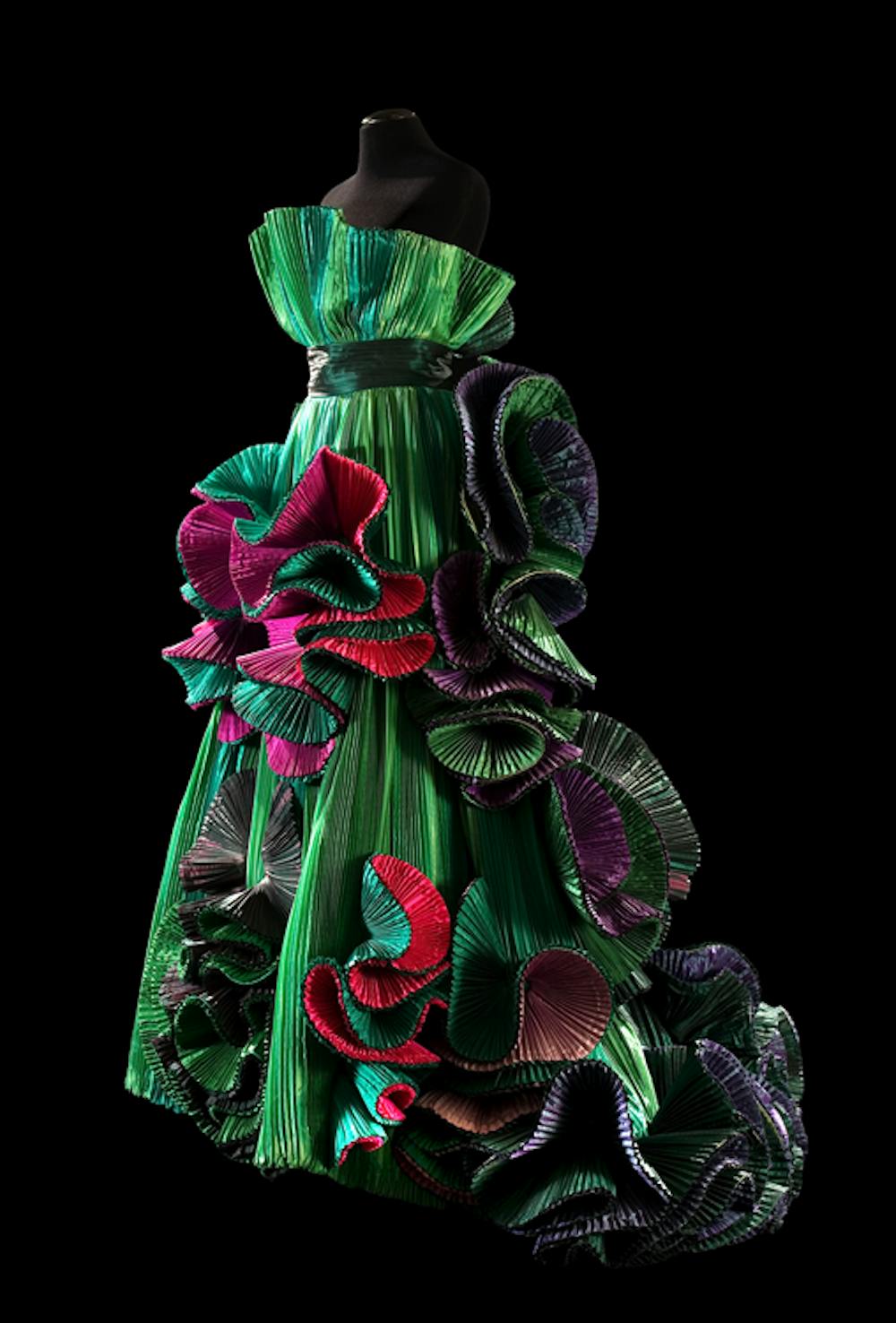As the spectator walks through the PMA’s “Roberto Capucci: Art into Fashion,” she watches as the familiar structure of a dress blurs into constructed and abstract sculpture. The exhibit skillfully shares the intertwined themes of history, nationalism, fashion, art and, most conspicuously, the drama of color and form. Together, these convey the story of Capucci’s rise to fame and establishment of a name synonymous with the avant–garde.
The exhibit begins in Italy in the 1950s, when the tale of the Italian fashion industry unfolds and a 21–year–old Capucci steps onto the scene. His early dresses in this section strongly resonate with organic, natural forms in their vivid color palette and in their bility to capture light with glowing silk. The collection gives each dress a multidimensional purpose as art, fashion and artifact.
Capucci’s famed dresses from this time period, Bocciolo (Rosebud) Dress, Calla Dress (inspired by a crisp white calla lily) and Nova Gonne Dress (reminiscent of the concentric circles that form when a stone is dropped in water), are not only timeless in their beauty and appeal, but also appear unaged — the silks still hold smoothly to the figures and glow as they reflect light. Here, Capucci’s knowledge of the female form is evident, as is the half–century of care these garment artifacts have enjoyed.
Next, exiting the geometric shapes of the late ’50s one enters the trippy texture and print patterns of the ’60s, when Capucci draws inspiration from rosary beads to the Pantheon — and the many influences in between. Here, Capucci plays with optical illusions, incorporating plastic elements into his clothes as his journey into the use of mixed media takes off.
As the chronological journey continues, the transition from dress to sculpture grows more obvious. Capucci incorporates bamboo, pebbles, straw and brass wire into his designs, creating what the exhibit curator, Dilys Blum, calls “kinetic sculptures.” As garments, these forms are created to move with the body of their wearer, but their actual shapes seem also to have lives of their own.
Perhaps the Colonna Dorica Dress (1978) may best exemplify this exciting period in Capucci’s work. As Capucci moves further toward sculpture, he begins to transcend the body as he creates imaginative shapes of all sizes and colors. Capucci makes the female form a canvas for his dresses, and despite his extravagance he still manages to flatter and highlight a woman’s greatest assets.
Rounding into the ’80s, Capucci leaves couture as he enters the world of a bona fide sculptor, using the female body as his base. One after another these dress–objects conjure up images of the natural world — as in Fuoco (1985, inspired by fire) — and of culture (inspired by Capucci’s travels to Asia and his time in Paris and Italy).
One may wonder what the next collection of dresses can possibly hold, and yet as decades pass Capucci dives further into art and creates dresses that are truly unique and remarkable; there is no boredom or predictability here. In the late ’80s Capucci begins to explore pleats and coloring. Like a painter using fabric as his medium, he creates nuanced greens and blues with careful layering.
At the end of the exhibit is Capucci’s most recent (2007) collection, the only one that displays sketches adjacent to finished works. Some sketches are more traditional, showcasing the dress’s fit on the model; others are more like cubist abstractions without the female form. It is a fun guessing game attempting to understand where the woman fits into each blue print.
With this Capucci collection the PMA brings a mix drama and fantasy, laying a runway of six decades worth of work and allowing us to decide where fashion ends and art begins.
Roberto Capucci: Art into Fashion Now – 6/5 Philadelphia Museum of Art 26th St. and Benjamin Franklin Parkway philamuseum.org







